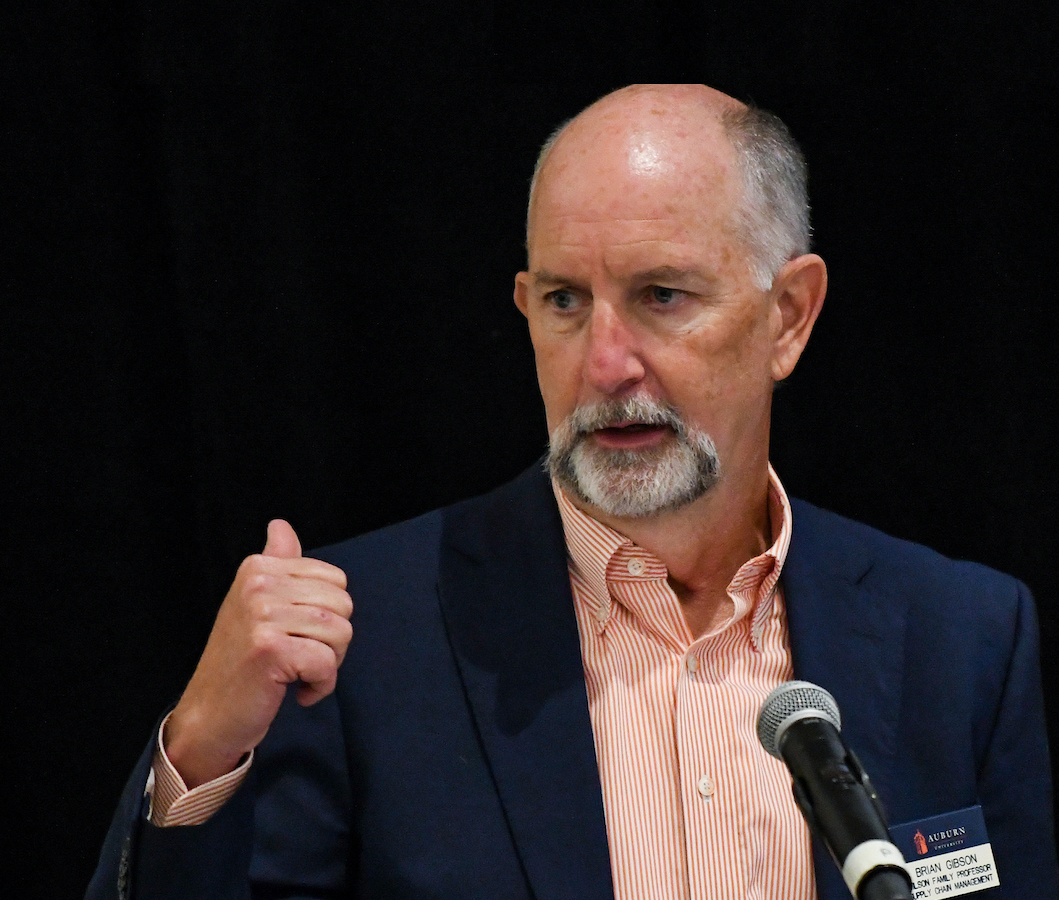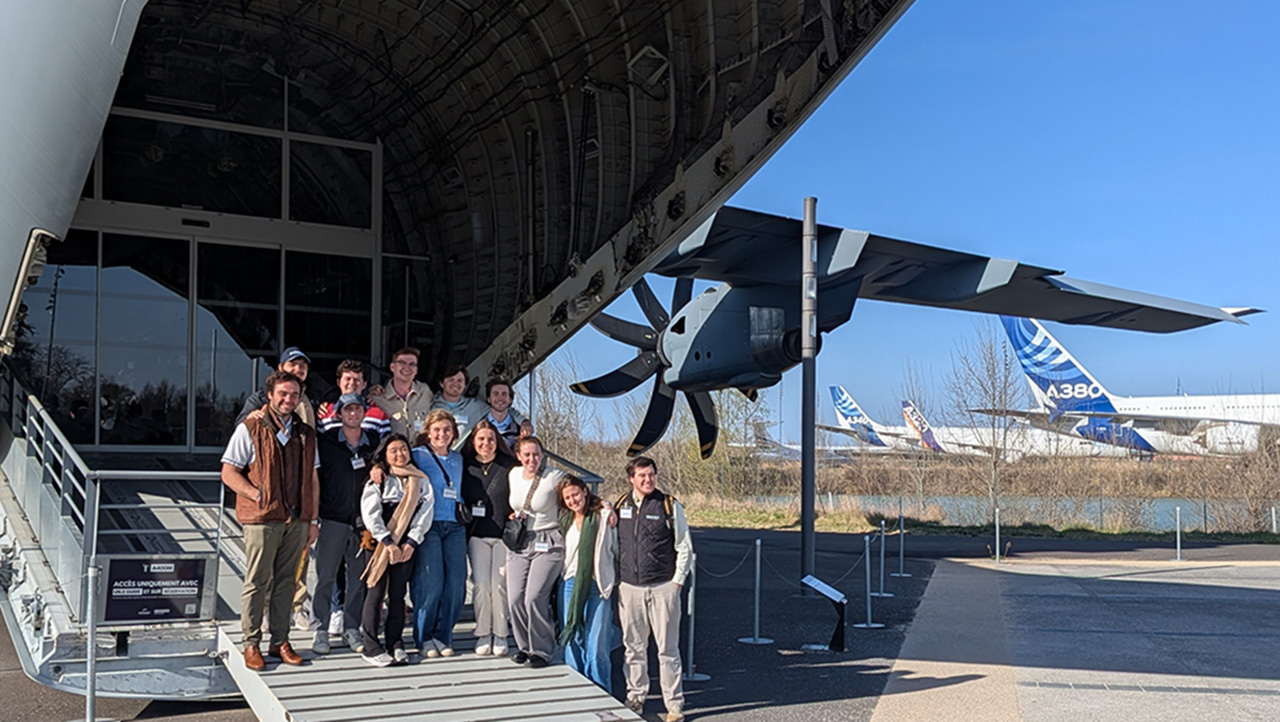| Harbert: |
How did this all come about? Pulling together such an exclusive look at what happens in an extremely secure international transportation facility couldn’t have
been easy. |
| Richey: |
No, it wasn’t, but I’ll defer to Tyler to walk you through how it all happened, since
he was the driving force. What I will say, however, is that this trip exemplifies
what’s possible when the value of our SCM programs, our partners in industry and the
power of the Auburn Family all come together. |
| Morgan: |
To begin with, all three of the factors Glenn just mentioned played a role in this
coming together as it did and why this relationship will continue to expand going
forward.
Let’s start with how this all came about. I had developed a couple of contacts at
JAS Worldwide and it was through their initial involvement that we were able to execute
the site visit. Executives from JAS had visited our campus in Fall 2021 and Spring
2022 to speak to our capstone class about the SCM industry. During one of those visits,
I discovered that a few members of the JAS leadership team have students attending
Auburn.
Two of those JAS executives, Graeme Robinson, Executive Vice President Operations and Matthias Frey, Vice President Airfreight Operations, told me that we have a really good, highly
ranked SCM program and that they’d be interested in being more closely involved.
|
| Harbert: |
So how did this general interest to become “more closely involved” with Harbert’s
SCM program – something many of our business partners express – turn into such a transformational
opportunity and experience?
|
| Morgan: |
JAS wanted to do something that really engaged our students and faculty in experiencing
and learning more about what they do, and Graeme thought he could get us into Hartsfield’s
International Cargo Terminal to see how the sausage is made, so to speak. And that
commitment proliferated across the very top levels of the JAS executive team.
It is important to note that our interest is expanding our JAS relationship was bolstered
by the reception JAS executives received following their classroom presentations.
Our students ranked their sessions as “some of the very best,” primarily because of
these executives’ openness to diving into the nuts and bolts of what they do.
|
| Harbert: |
That makes sense for Harbert, but what was the motivation behind JAS’s willingness
to jump through all the hoops required to arrange this level of access and – importantly
– robust cooperation from so many organizations? |
| Morgan: |
According to Matthias Frey, at JAS, the company is constantly looking to engage with
diverse, high-potential bright minds of the next generation. One of the ways they
feel they can do that is to create meaningful experiences for our students and faculty
to help illustrate the promising career possibilities available in our fascinating
and increasingly relevant industry. |
| Harbert: |
So, let’s talk about the day you all spent with JAS and their SCM partners. |
| Morgan: |
It began at JAS’s headquarters in Sandy Springs, right outside of Atlanta, where the
company hosted a luncheon for our small group of 20 students and faculty. The President
and CEO of JAS, Marco Rebuffi, came down and spoke personally with us over lunch.
That was more than we expected, and really set off the beginning of a great day full
of unexpected experiences. We were not expecting to be standing in the cargo hold
of a Qatar Airways jet or meeting officers from the popular TV show “To Catch a Smuggler.”
More on that later.
From there we went to Hartsfield-Jackson International Airport, where we were greeted
by Tracy Gilbert, Hartsfield’s Community Affairs Manager, Department of Aviation.
JAS pulled in officials from Swissport, because it was in their bonded warehouse that
cargo gets pulled off the plane and additional cargo get loaded on. JAS also enlisted
Qatar Airways, the actual carrier, and U.S. Customs and Border Protection. That’s
five separate entities trying to coordinate this – I don’t believe the airport has
ever done anything like this before.
|
| Harbert: |
Were there any restrictions as to what you could see? What you could and couldn’t
do?
|
| Morgan: |
I imagine there were some things we weren’t allowed to see, but I can’t think of any
at the moment. The access we were given went well beyond what any of us could have
anticipated. The only thing that limited us was the ratio of students and faculty
to airport and customs officials. We couldn’t bring more than 20 or so people, and
for every four of us there had to be one customs board patrol agent or a person from
the airport itself escorting us at all times.
|
| Richey: |
So, we're pulling into the back entrance of the facility where the cargo freight is
handled and there is this Boeing 777 touching down and rolling in with a big Qatar
Airways logo. The plane stops and after they go through a bit of paperwork the two
customs agents step up and say we’re good to go. They open up the plane and this huge
lift goes up to offload pallets from the two stories of stored freight on the plane
and they start pulling cargo off and putting more pallets of cargo on.
They took the time to bring our students and faculty onto the plane three or four
times to actually walk through it all, to see how the interior of the plane is set
up. They were busy loading up sports cars from a recent race and fitting them into
the cargo hold along with pallets of other cargo. It was fascinating. And we got to
meet a member of the cast of To Catch a Smuggler – he’s actually a customs border patrol agent at the airport. Reality TV meets reality. |
| Morgan: |
We were then treated to a presentation by four or five customs agents about everything
that goes into the landing, offloading and onboarding of cargo we’d just witnessed.
They walked us through an overview of how they find contraband, including a demonstration
of their specially trained German shepherds smelling out explosives. They also described
their team of beagles that roam through the warehouse sniffing out certain types of
plants or foods that are in illegal to be in the United States. They even showed us
this van they have that opens up on both sides so they can put cargo through an x-ray
machine that can see through most metals – it was really cool.
|
| Harbert: |
In closing – and recognizing that there is so much more we could talk about regarding
this phenomenal trip – what message would you like to convey about this extraordinary
event?
|
| Richey: |
Two points: First, trips like this are great for our students because it is really
hard to convey what the global supply chain is all about from a textbook alone. This
exceptional level of engagement allows them to get their feet wet and ask “Hey, is
this something I really want to do?” That’s immeasurable insight, regardless of whether
they end up in supply chain management.
The second take-away is that the relationships we're building and the companies that
are eager to work with us and our students in uniquely compelling ways continues to
grow. It is really all about the students, the reputation of Auburn and specifically
the Supply Chain Management Department, and the power of the Auburn Family that played
a key role in progressing this increasingly valuable relationship.
|
| Morgan: |
For me, I remain struck by the power of the Auburn Community. A chance encounter with
a father moving his incoming student into a dorm turned into a personal connection
and corporate partnership, resulting in an experience for Harbert’s SCM students like
no other.
War Eagle!!
|

 Degrees & Programs
Degrees & Programs
 Faculty & Staff
Faculty & Staff
 Career Development
Career Development
 Recruiters & Industry
Recruiters & Industry





